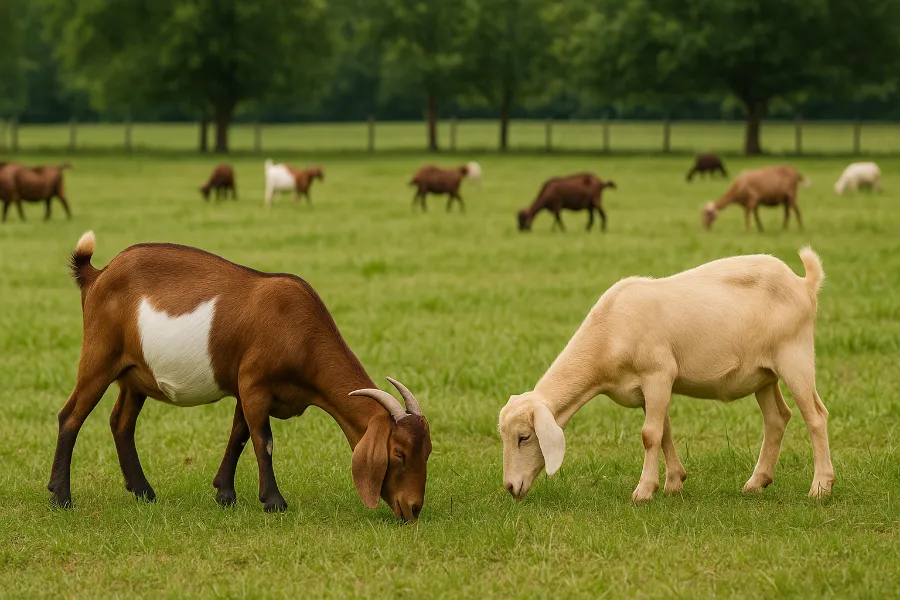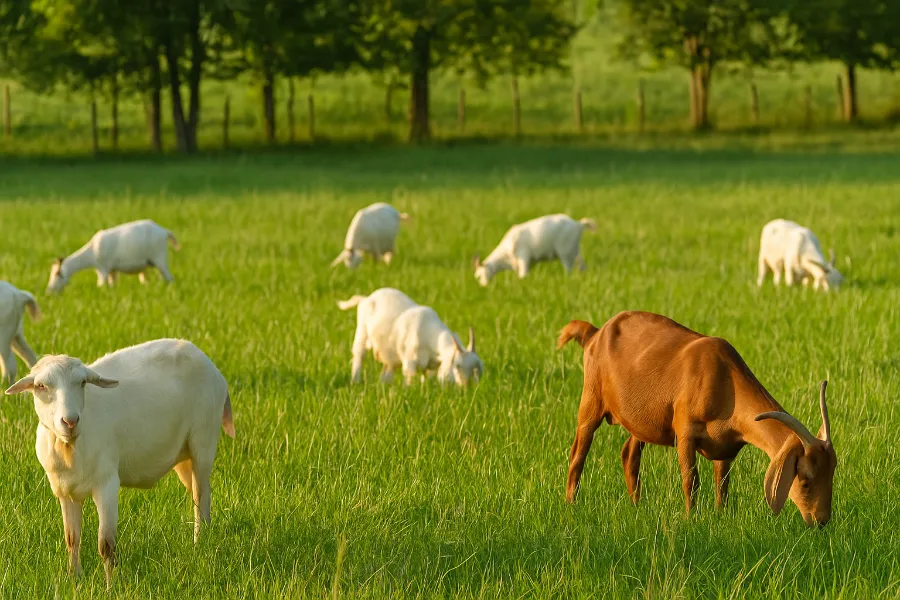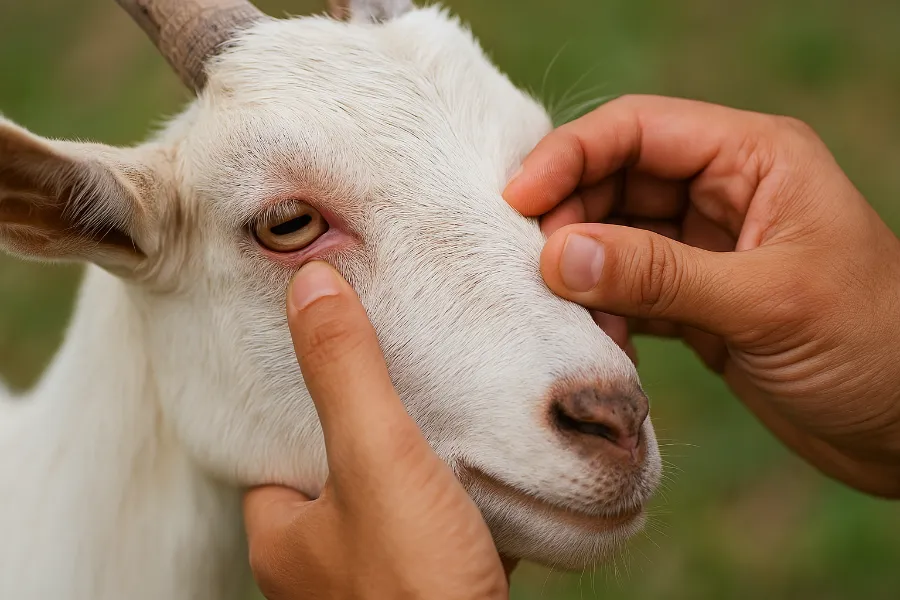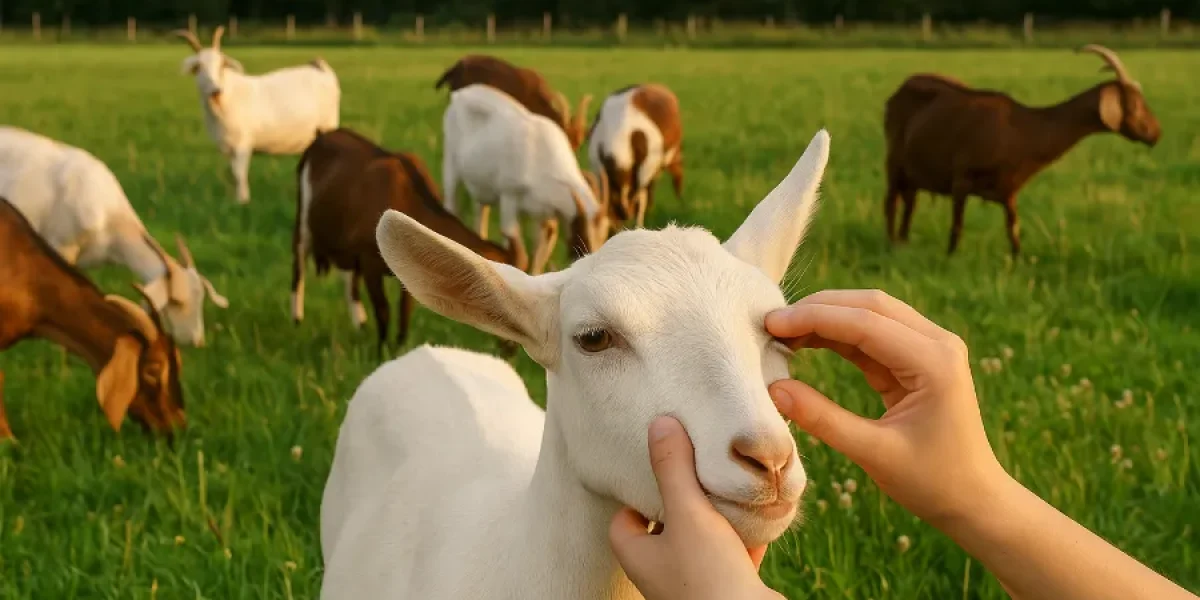From the moment I started raising goats, I learned one golden rule: whenever you lift a goat’s lower inner eyelid and examine its color, you’re literally peeking into the animal’s bloodstream. That’s why I’m diving into how to use the goat eyelid as your first line of defense.
In this post, I’ll share what I’ve learned about reading eyelid color, spotting anemia, and using modern tools like FAMACHA for better herd health. You’ll see why this tiny daily habit is a cornerstone of smart goat care, the key to fighting goat disease, and one of the simplest yet most powerful techniques in sustainable goat farming.

Goat Anemia: The Hidden Threat Behind Pale Eyelids
One of the most common issues I’ve faced on the homestead is goat anemia—and those pale eyelids are often the first clue. Simply put, anemia means too few healthy red blood cells, which leads to poor oxygen delivery throughout the body.
In goats, that usually shows up when the eyelid membrane goes from a healthy red or rosy pink to pale pink, whitish, or even gray. The culprit behind it is often the barber-pole worm, an internal parasite that feeds on blood inside the goat’s stomach. But it’s not always worms—sometimes nutritional deficiencies like low iron or copper, chronic diseases, or even blood loss after kidding are to blame.
The good news? A thirty-second eyelid check can reveal the problem before it gets serious. When you get into the habit of checking, you start catching these small shifts before your goat becomes weak or stops eating.
Anemia in Goats: What the Goat Eyelid Tells You
The goat eyelid is one of nature’s best diagnostic tools. Because the tissue inside the lower lid is thin and full of capillaries, its color changes quickly when red blood cell levels drop.
When you pull down that eyelid, what you’re really doing is checking oxygen circulation and hemoglobin levels.
- A deep red or bubble-gum pink color means healthy blood.
- A light pink color means mild anemia.
- A pale or whitish color means severe anemia that needs immediate attention.
Once you’ve practiced this a few times, it becomes second nature. You can often tell at a glance whether a goat is vibrant and healthy or silently struggling. That’s the beauty of reading the eyelid—it’s fast, reliable, and doesn’t require any fancy tools.
Goat Care: Making Lid Checks Part of Your Routine
In my goat-keeping routine, checking eyelids is as normal as filling water buckets or trimming hooves. Here’s how I make it part of everyday goat care:
- Catch each goat calmly. Hold the head steady but gently.
- Pull down the lower eyelid in natural daylight so you can see the true color.
- Compare the color to what you know as normal for that goat.
- Log the result—just a quick note with the goat’s name and the eyelid color.
- Repeat often. During warm, humid seasons, I check every 1–2 weeks; during cooler, dry seasons, once a month is enough.
If I find a goat with a pale eyelid, that goat immediately gets extra attention. I’ll look for other symptoms—bottle jaw swelling, rough coat, weight loss—and decide whether to deworm, adjust minerals, or call the vet.
This tiny habit builds consistency. Over time, it becomes your early-warning system—the difference between catching a problem early and discovering it too late.
FAMACHA: The Standardized System for Eyelid Reading
Now let’s talk about the method that turned the humble eyelid check into a science: FAMACHA.
Developed by veterinarians, FAMACHA uses a color-coded chart that lets you score each goat’s eyelid color from 1 to 5. The goal is to measure how anemic the goat is and decide whether treatment is necessary.
FAMACHA Scoring Guide:
| Score | Eyelid Color | Interpretation |
|---|---|---|
| 1 | Deep red | Excellent, no anemia |
| 2 | Pinkish red | Slight concern, monitor closely |
| 3 | Light pink | Moderate anemia, treat selectively |
| 4 | Pale pink | Severe anemia, treat immediately |
| 5 | White | Life-threatening anemia, emergency care |
To use it, you simply compare your goat’s eyelid color to the chart and assign a score. Only goats scoring 3 or higher should be dewormed or treated for anemia. That selective approach helps prevent resistance to deworming medications and keeps your herd healthier in the long run.
I remember when I first started using FAMACHA—it made my checks far more consistent. Before, I was relying purely on “eyeballing it.” Now I have a measurable system that lets me compare goats week to week and season to season.
Goat Disease: Beyond Worms—What Else Can Eyelid Color Reveal?
While worms are the main culprit behind anemia, goat disease can also affect eyelid color. Your goats’ eyes often reveal deeper problems than you might expect.
Here are a few other health conditions that cause paleness:
- Liver fluke or tick-borne infections that destroy red blood cells.
- Chronic respiratory or digestive infections that suppress red cell production.
- Nutritional deficiencies—especially copper, iron, or selenium deficiencies.
- Heavy lice or mite infestations that lead to gradual blood loss.
So when you see a pale eyelid, think beyond deworming. Look at nutrition, external parasites, and overall condition. Often, multiple factors work together to cause anemia. Identifying the true cause ensures your treatment actually solves the problem rather than masking it.

Goat Farming: How Eyelid Checks Fit Into Sustainable Management
In modern goat farming, the eyelid check is one of the most cost-effective tools for herd health. It costs nothing, takes seconds, and gives you insight into the goat’s overall condition.
Here’s why it’s indispensable for sustainable goat management:
- It prevents unnecessary deworming. Only treat goats that truly need it.
- It reduces parasite resistance. By avoiding overuse of dewormers, you keep medications effective longer.
- It improves productivity. Goats with healthy red blood cells grow faster, milk better, and breed more efficiently.
- It supports humane care. You catch illnesses early and reduce suffering.
For me, eyelid checks have become a foundational practice—right alongside pasture rotation and mineral supplementation. When you make them part of your farm rhythm, you notice your herd becoming more resilient year after year.
Understanding the Biology Behind the Goat Eyelid
So why does the goat eyelid tell us so much? It comes down to blood chemistry.
The red tint you see in a healthy eyelid comes from hemoglobin—the iron-rich protein that gives red blood cells their color and carries oxygen. When red blood cells are destroyed (by parasites, disease, or poor nutrition), the hemoglobin level drops. As a result, the eyelid tissue fades from bright red to light pink or white.
Because the eyelid membrane is thin and easy to see, these changes show up long before other signs appear. That’s why you can detect anemia early—often before a goat loses weight or energy. It’s the perfect natural diagnostic window.
Step-by-Step: My Eyelid-Checking Routine
If you’re new to checking eyelids, here’s a simple process you can follow:
- Choose good lighting. Natural daylight works best.
- Secure the goat gently. Hold the head still but don’t force it.
- Pull down the lower eyelid. Use your thumb to expose the inner tissue.
- Check the color. Compare it to the FAMACHA scale or your mental reference.
- Record the result. Write it down, or use a note app on your phone.
- Follow up. If the goat scores 3 or higher (light pink or paler), take action—treat, supplement, or call your vet.
I usually combine this with other checks—body condition scoring, hoof trimming, and mineral refills—so it feels less like an extra task and more like part of my regular herd rhythm.
Preventing Goat Anemia Before It Starts
While eyelid checks help you detect problems, good management helps you prevent them. Here are my best prevention strategies:
- Rotate pastures every 4–6 weeks to interrupt the worm life cycle.
- Avoid overcrowding, which increases parasite pressure.
- Feed a balanced diet with enough minerals—especially copper, iron, and selenium.
- Provide clean, fresh water at all times.
- Keep bedding dry and pens well-ventilated to reduce external parasites.
- Deworm strategically, based on eyelid color, not habit.
- Keep records. Patterns often reveal themselves—certain goats might be more prone to anemia than others.
Anemia prevention is really about consistency. When goats get the same level of care week after week, their systems stay strong and parasites have less opportunity to take hold.
The Cost of Ignoring Pale Goat Eyelids
I’ve learned this lesson the hard way: ignoring a pale eyelid can lead to tragedy. Anemia in goats isn’t just a cosmetic issue—it’s a life-threatening condition.
Untreated anemia can cause:
- Organ failure due to lack of oxygen
- Collapse and sudden death
- Poor growth and weight loss
- Infertility or miscarriage in breeding does
- Weakened immunity that invites other infections
Even if a goat survives, recovery is slow and draining—for both you and the animal. The best approach is always prevention through awareness.
How Eyelid Checks Support Sustainable Goat Care

One of the most satisfying things about goat farming is finding ways to balance productivity and compassion. Eyelid checks do exactly that.
They let you:
- Care for your goats holistically
- Reduce chemical dependence
- Build parasite resistance naturally
- Save money on unnecessary treatments
- Improve herd longevity
The longer I keep goats, the more I realize that sustainability isn’t just about feed or fencing—it’s about attention. Every time you lift an eyelid, you’re practicing conscious, observant animal care.
Final Thoughts: The Goat Eyelid as Your Herd’s Health Barometer
If there’s one skill every goat keeper should master, it’s reading the goat eyelid. It’s quick, it’s free, and it tells you more than any feed bag label ever could.
Those few seconds of observation can prevent suffering, save a goat’s life, and strengthen your entire herd. Combine it with proper goat care, use the FAMACHA chart for accuracy, stay alert for goat disease, and practice responsible goat farming—and you’ll have a thriving, resilient herd that rewards your effort many times over.
FAQs
The goat eyelid shows the color of blood vessels just beneath the surface, making it a clear indicator of blood health. By checking it regularly, you can detect anemia early before serious symptoms appear.
A healthy goat eyelid should be a deep pink to reddish color. Pale pink, whitish, or gray eyelids usually signal anemia or poor blood circulation.
During warm and humid months, check every 1–2 weeks since parasites thrive in those conditions. In cooler or dry seasons, monthly checks are usually enough.
Barber pole worms are the main cause, but external parasites, poor nutrition, and chronic disease can also lead to anemia in goats. Early detection through eyelid color prevents life-threatening complications.
FAMACHA is a color-coded system that scores eyelid color from 1 (healthy) to 5 (severe anemia). It helps farmers treat only goats that truly need deworming, reducing resistance and maintaining herd health.
Yes, sometimes pale eyelids point to mineral deficiencies or infections instead of parasites. Always consider diet, body condition, and other symptoms before deciding on treatment.
Rotate pastures, provide mineral supplements, and monitor eyelid color regularly. Consistent checks and balanced nutrition are your best defense against anemia.













